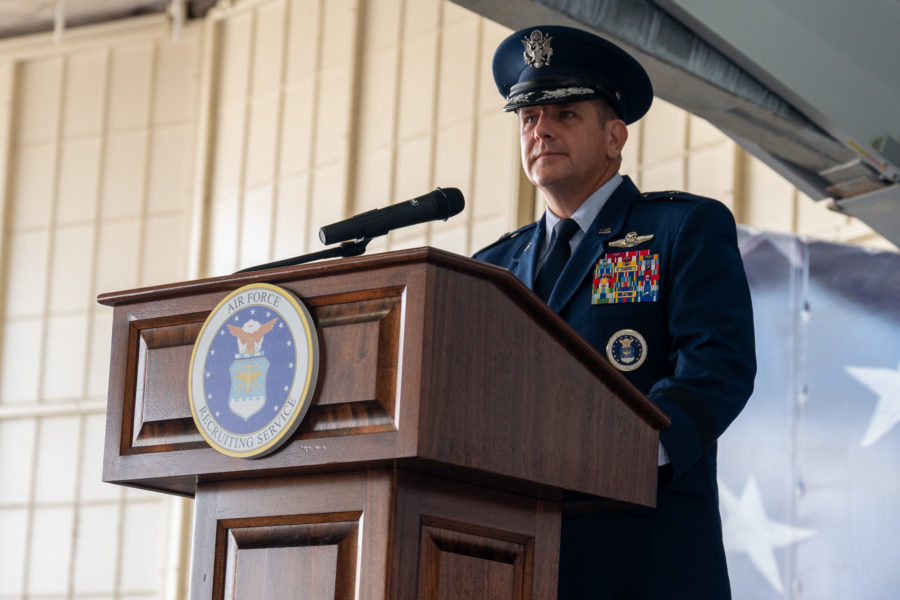Brig. Gen. Christopher R. Amrhein, an experienced tanker and trainer pilot who helped oversee the Air Force’s flying training enterprise, took command of the Air Force Recruiting Service on June 2, taking on the service’s persistent problems in finding qualified candidates interested in joining the military.
Amrhein succeeds Maj. Gen. Ed Thomas, who led AFRS from June 2020 through May 2023. That tenure encompassed the COVID-19 pandemic, low unemployment, and declining eligibility and propensity to serve among American youth, the Air Force and the military writ large struggled to meet their recruiting goals in fiscal 2022 and are faring no better in 2023.
Indeed, Amrhein takes command of AFRS just four months before the end of the fiscal year, fully expecting all three Air Force components—Active-Duty, Guard, and Reserve—to miss their recruiting goals.
Things are improving. Early this year, Air Force leaders predicted the Active Duty recruiting would miss goal by 10 percent, while the Guard and Reserve would miss by even larger margins. But on June 7, Chief of Staff Gen. Charles Q. Brown Jr. said at a Mitchell Institute for Aerospace Studies event that it might not be that bad after all.
“We’ll probably be something less than 10 percent short, particularly on the Active-Duty,” Brown said. “It’s a little higher on the Guard and Reserve. Part of that is based on retention. Our retention rates are really high right now.”
While some recruiting roadblocks have eased—recruiters are now more able to conduct in-person visits to high schools with the end of the pandemic—others will be more difficult to overcome.
According to Pentagon data, just 23 percent of Americans 17 to 24 years old are eligible to join without being granted a waiver, and only 9 percent express an interest in doing so. Both figures have been trending downward for years, and lack of familiarity with the military may be the greatest cause.
“This has been a slow-moving train that’s been coming at us for decades, frankly,” Thomas said in March at the AFA Warfare Symposium. “There are less veterans, less service members, less bases, less opportunity to be exposed to what it means to serve in uniform today.… The longer-term challenge of lack of familiarity is one that we’re going to have to come to grips with as a nation.”
To combat that problem, Thomas and Brown advocated for “reintroducing” the Air Force to America by increasing community engagement and opening up military bases in a way not seen since before 9/11.
“After 9/11, all of our bases became fortresses because we made it very difficult to get on base,” Brown said June 7. “And so I sent out a letter to all our Wing Commanders back in January and basically instructed them to ‘Open your base and get into the community.’ People only aspire to be what they see.”
In the change-of-command ceremony at Joint Base San Antonio-Randolph, Texas, both Amrhein and Air Education and Training Command boss Lt. Gen. Brian S. Robinson acknowledged the difficult task Amrhein now faces.
“We are eager to join this team of professionals in a challenging time,” Amrhein said of himself and his new command chief, Chief Master Sgt. Rebecca Arbona. “With challenges come opportunities and I look forward to rolling up my sleeves and working with all as we continue the great work being done daily, while exploring those new opportunities.”
Amrhein can look forward to high-level help confronting his recruiting challenges. Vice Chief of Staff Gen. David W. Allvin—widely presumed to be nominated to replace Brown as CSAF once he becomes Chairman of the Joint Chiefs—recently championed a Barriers to Service Cross-Functional Team focused on cutting through red tape and changing Air Force policies seen as barriers to recruiters.
Prior to taking command of AFRS, Amrhein was the 19th Air Force’s vice commander and briefly its interim commander after Maj. Gen. Phillip A. Stewart was relieved May 10 for loss of confidence in his ability to command.
Amrhein also previously served as inspector general for Air Mobility Command and commander of the 100th Air Refueling Wing at RAF Mildenhall, U.K. A KC-135 pilot out of training, he also spent time as an instructor pilot on the T-37 and T-6.
